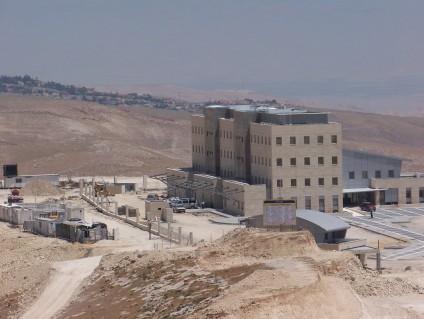UPDATES
E1 “cutting the West Bank in half”?
Dec 11, 2012 | Ahron Shapiro

The Australian‘s Middle East correspondent John Lyons filed back to back stories on December 7 and 8 sounding the alarm over Israel’s decision on E1. In those articles, Lyons made the erroneous and unsubstantiated claim that E1 would bisect the West Bank.
In his first article, Lyons went so far as to say that E1 would mean death for the two-state peace formula.
“Only 12sq km, the E1 is between Jerusalem and the Jewish settlement of Maaleh Adumim. Settling it would cut the West Bank in half.
The E1 would mean a two-state solution – An Arab state alongside a Jewish state, as outlined by the UN’s partition plan of 1947 – was dead.”
In his second article, Lyons began by making the dubious claim that E1 constitutes a new settlement – dubious given that it has been officially part of Ma’ale Adumim’s municipal plan since 1994 and would be considered by Israel to be a new neighbourhood for the town.
Also, Lyons embellished upon his claim from the previous day that E1 would sever the West Bank into two parts. However, he also softened somewhat his earlier absolutist rhetoric on the prospect of a two-state deal after E1, saying it would not be rendered impossible, only nearly so.
“Israel announced its intention to proceed with a new settlement, E1.
E1 has long been opposed by the US and Europe because it would cut the West Bank in half, making a Palestinian state barely feasible. Given Gaza is geographically separate, it would mean a state divided into three sections, with restricted access to East Jerusalem, which Palestinians want as their capital.”
Lyons claims were not greatly different to those of other noted international correspondents, particularly New York Times‘ Jerusalem Bureau Chief Jodi Rudoren. In recent days, the NYT has issued corrections to Rudoren’s stories that can and should have direct implications for Lyons’ claims as well.
As reported by the US media watchdog CAMERA, the New York Times issued two separate but related corrections to their articles.
The first, on December 7, about an article [by NYT Jerusalem Bureau Chief Jodi Rudoren] entitled “Dividing the West Bank, and Deepening a Rift,” which was originally published on Dec. 2, 2012, clearly acknowledged that construction in the E-1 corridor would not “divide the West Bank in two” nor “make a contiguous Palestinian state impossible.”
An earlier version of this article referred imprecisely to the effect of planned Israeli development in the area known as E1 on access to the cities of Ramallah and Bethlehem from Jerusalem, and on the West Bank. Such development would limit access to Ramallah and Bethlehem to only narrow corridors far from the Old City and downtown Jerusalem. It would also create a large block of Israeli settlements in the center of the West Bank; it would not divide the West Bank in two.
Because of an editing error, the article referred incompletely to the possibility of a contiguous Palestinian state. Critics see E1 as a threat to the meaningful contiguity of such a state because it would leave some Palestinian areas connected to one another by roads with few exits or by circuitous routes; the proposed development would not, technically, make a contiguous Palestinian state impossible. [emphasis added]
The second correction, on December 8, walked back allegations made by NYT reporters about the effect development of E1 would have regarding Palestinian access to Jerusalem:
[The first] addresses claims about access to Jerusalem from the West Bank and is appended to an article [by Rudoren and Mark Landler] entitled “Housing Move in Israel Seen as Setback for a Two-State Plan” originally published on Dec. 1, 2012.
The correction in full reads:
Because of an editing error, an article last Saturday about Israel’s decision to move forward with planning and zoning for settlements in an area east of Jerusalem known as E1 described imprecisely the effect of such development on access to the cities of Ramallah and Bethlehem from Jerusalem. While development of E1 would limit access to Ramallah and Bethlehem to narrow corridors far from the Old City and downtown Jerusalem, it would not completely separate those cities from Jerusalem.
Another important development on the E1 story occurred on December 5, when former US Deputy National Security Advisor Elliot Abrams told the ABC’s Emily Bourke in a phone interview that he felt that the allegations behind the current controversy were “greatly exaggerated”.
EMILY BOURKE: But given the placement of this settlement and this push into the E1 land tract, is that not deliberately provocative, is that not problematic as far as a two state solution goes?
ELLIOT ABRAMS: You know I think it’s been greatly exaggerated. Again, it’s not some kind of right-wing plot. Rabin and Barak both planned to build in E1. The Clinton parameter, the Olmert plan, all assumed that E1 would be part of Israel in its final settlement.
The thing is you’ve got a town, Ma’ale Adumim, of 40,000 people that’s like a balloon tethered to Israel by one road and that’s just never going to stand. I don’t understand really the argument that it destroys the possibility for Palestinian states.
EMILY BOURKE: But is it not the case that it virtually bisects the West Bank and renders a Palestinian state unviable?
ELLIOT ABRAMS: No, I think that’s wrong. There are two ways to solve the problem. Build a road that is east of Ma’ale Adumim where there’s about 15 miles as I recall it between Ma’ale Adumim and the Jordan River. Or there’s a road that goes between Jerusalem and Ma’ale Adumim. So build an overpass or build an underpass.
But the notion that it makes a Palestinian state impossible, I mean it’s ironic that this argument comes the week after the UN has declared there is a Palestinian state. I mean they admitted the Palestinian state as a non-member state of the United Nations. They raised the status from into each a state.
So I just don’t think it makes it unviable. You just build an overpass or an underpass. It is not a decision to construct. There will not be one shovel hitting the earth. It’s just another stage in this endless planning stage that has been going on for about 30 to 40 years. It is not a decision to construct anything in E1.
On a parting note, a couple of informative maps have turned up better illustrating that the claim that E1 cuts the West Bank in two just doesn’t wash.
The first map is from Google and appears in a blog post at the Times of Israel. Taken from a distance, it puts the general area in perspective.
Another map – this one from Ha’aretz, shows the area close-up. What stands out here is the small area the new neighbourhood would take up in the entire E1 tract, or in comparison to other neighbourhoods – both Jewish and Arab – in the vicinity.
Lastly, CAMERA has linked to a map that appears in a book of former US Middle East envoy Dennis Ross which shows E1 as part of the Clinton parameters for a two-state outcome.
Ahron Shapiro
Tags: Israel











